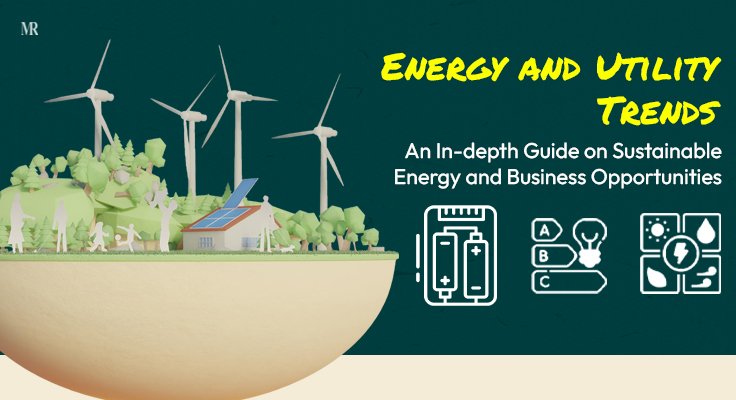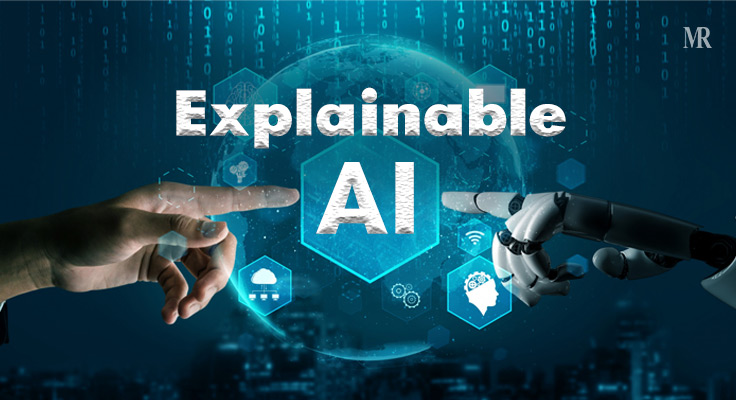Energy and utility sectors are vital to our daily lives. They provide the electricity that powers our homes, businesses, and infrastructure. Understanding energy and utility trends is essential for everyone, especially those interested in future business opportunities. These trends shape how we consume energy and influence market dynamics.
As we approach 2025, remarkable shifts reshape energy consumption and production. For example, companies like GridFabric are using technology to integrate renewable energy sources effectively. Additionally, startups like Wenergie are making decentralized solar power accessible to individual consumers.
Understanding energy and utility trends becomes crucial as the world evolves. These trends not only reflect the changing landscape of energy but also influence business opportunities. Recognizing these shifts allows individuals and companies to adapt and thrive in this dynamic environment.
In this blog, we will explore the key trends shaping the energy and utility sectors in 2025. We will highlight their significance for both consumers and businesses, emphasizing the exciting opportunities they present in a sustainable future.
Understanding the Energy and Utility Industry
The energy and utility industry economics are currently experiencing transformative changes influenced by sustainability, technology, and regulatory frameworks. Both electric and gas utilities are significantly investing in renewable energy sources. This investment aligns with global movements toward sustainability and reducing reliance on fossil fuels. In 2025, this trend will continue as utilities transition to new renewable energy technologies.
Demand for electricity is expected to rise notably in the near future. Forecasts indicate a 4.7% growth in electricity demand over the next five years. Factors such as industrial expansion and the increasing prevalence of electric vehicles (EVs) will drive this demand. For instance, electric vehicle sales are projected to reach nearly 16.7 million units in 2024, representing a notable increase from previous years.
The Inflation Reduction Act has spurred investments in renewable resources and clean technology, leading to job creation within the sector. The energy and utility industry has seen a surge in enthusiasm, projecting the creation of over 170,000 new clean energy jobs since the enactment of this act.
As demand for cleaner energy grows, businesses that adapt quickly and strategically will likely experience success in 2025 and beyond. Recognizing and embracing these energy and utility trends will empower stakeholders to effectively navigate the changing landscape.
Energy and Utility Trends 2025
We have listed the top energy and utility trends of 2025 below.
| Renewable Energy Trends | 1. Solar Energy 2. Wind Energy 3. Hydropower 4. Other Renewable Energy (geothermal, biomass, tidal, and wave energy) |
| Energy Efficiency Trends | 1. Smart Grid Technology 2. Energy-Efficient Appliances 3. Building Energy Efficiency |
| Energy Storage Trends | 1. Grid-Scale Battery Storage 2. Residential Battery Storage 3. Battery Storage Technologies |
| Electric Vehicle Trends | 1. EV Adoption 2. EV Battery Technology |
Renewable Energy Trends
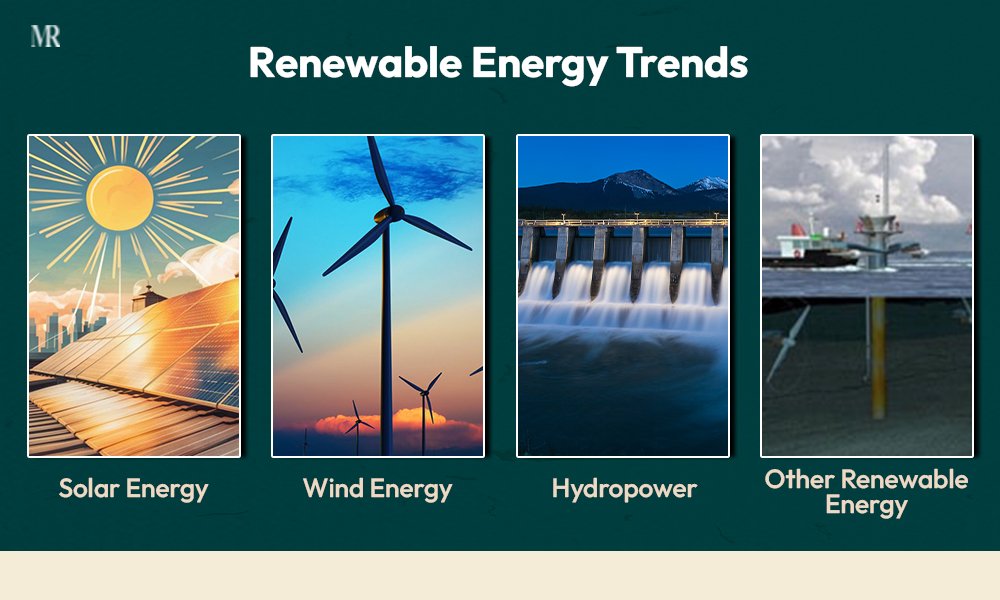
The renewable energy sector is one of the fastest-growing sectors. To understand it better, we have classified it into four main subsectors.
- Solar Energy
Solar panel technology is advancing rapidly, with significant improvements in efficiency and affordability. For example, the average cost of solar installations has fallen by over 40% in the past decade, making solar energy more accessible. This declining cost, along with technological innovations, encourages greater adoption in both residential and commercial sectors.
According to the International Energy Agency, global solar photovoltaic (PV) installations reached between 407 GW and 446 GW in 2023, significantly boosting cumulative capacity to 1.6 TW. This impressive growth reflects a broader shift towards renewable energy sources across both residential and commercial sectors.
- Wind Energy
The levelized cost of electricity (LCOE) for onshore wind has significantly dropped, aligning with the latest energy and utility trends. In 2022, onshore wind’s average LCOE reached approximately $39 per megawatt-hour (MWh), while offshore wind ranged between $52 and $184 per MWh, depending on location and technology. With ongoing advancements in wind technology, energy and utility trends suggest these costs will continue to decline, boosting the economic feasibility of wind projects even further.
The total investment cost of an average turbine installed in Europe is around €1.23 million/MW, with the turbine itself accounting for approximately 76% of this cost. Offshore wind projects also face unique costs, averaging between €2.0 to €2.2 million/MW for near-shore facilities.
- Hydropower
Hydropower is a significant source of renewable energy worldwide, providing nearly 60% of the global renewable electricity supply. Innovation and research could enhance its operations to make it more reliable.
Innovations such as stabilizer fins, adjustable diaphragms, and air-water injection systems are being explored to enhance operational flexibility. These advancements enable hydropower plants to better integrate with variable renewable energy sources like wind and solar, providing essential grid stability.
Studies suggest that digital upgrades could add up to 42 terawatt-hours (TWh) to current hydropower production, leading to significant cost savings and reduced greenhouse gas emissions. The use of digital twins—virtual models of physical systems—will enable operators to simulate different scenarios and enhance decision-making processes.
- Other Renewable Energy
Various renewable energy sources, such as geothermal, biomass, tidal, and wave energy, demonstrate a promising trajectory for the transition to sustainable energy systems. Emerging technologies within these sectors are poised to enhance efficiency, reduce costs, and increase the scalability of renewable energy projects.
Emerging technologies across these four renewable sectors have immense potential to revolutionize how energy is produced and consumed. For geothermal energy, advancements in drilling technology and resource assessment are promising to unlock new geothermal resources.
In biomass, the optimization of conversion processes can enhance yield and reduce costs. For tidal and wave energy, innovative designs and deployment strategies are critical to overcoming historical challenges related to cost and environmental impact.
Investment in research and development is crucial to realizing the full potential of these technologies, as government support and collaboration with industry stakeholders play key roles in advancing renewable energy.
Energy Efficient Trends
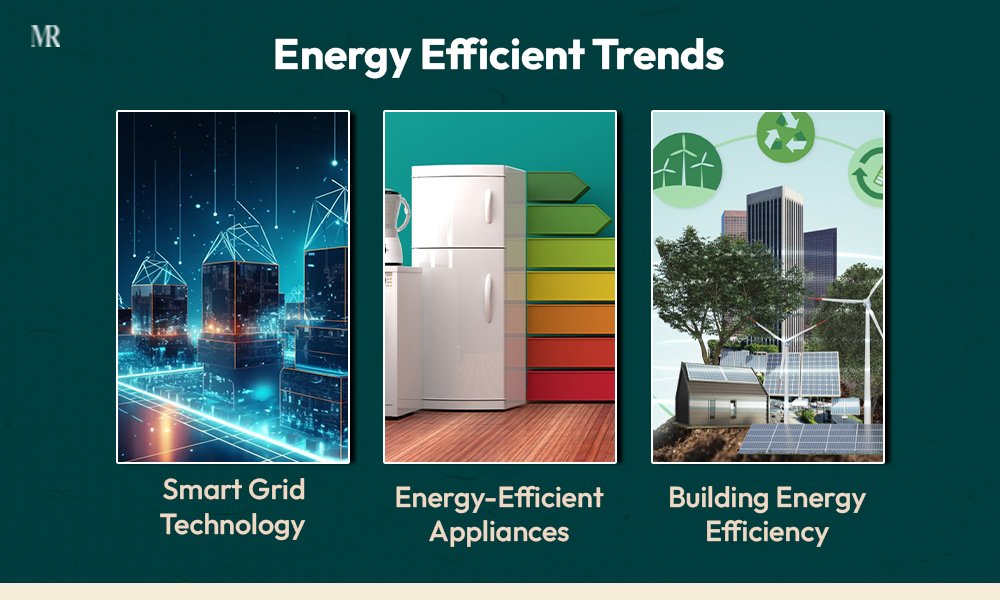
- Smart Grid Technology
Smart grid technology, a key driver in energy and utility trends, offers numerous benefits such as improved security, reduced operational costs, and better integration of renewable energy sources. For seamless integration of distributed energy resources, implementing advanced IEEE 2030.5 development enables utilities to enhance communication protocols and ensure
By using advanced communication and control systems, smart grids enhance the reliability and efficiency of electricity distribution, ultimately lowering energy costs for consumers. These energy and utility trends also enable real-time data monitoring and demand response capabilities, balancing the grid more effectively during peak demand periods.
Comprising various technologies, smart grids are central to energy and utility trends. They include smart meters, advanced sensors, communication networks, and automated control systems. These components streamline the transmission of information between utilities and consumers, enabling more efficient energy management.
Furthermore, smart appliances and energy storage systems, another aspect of energy and utility trends, improve the grid’s responsiveness to supply and demand fluctuations, optimizing overall performance.
However, high initial costs, regulatory barriers, and cybersecurity concerns remain significant challenges that utilities and governments must tackle to fully realize these benefits.
- Energy-Efficient Appliances
Modern energy-efficient appliances incorporate advanced technologies to minimize energy use while maintaining performance. For example, today’s refrigerators use one-third of the energy consumed by models from 1973, while providing greater storage capacity. Technologies such as solid-state lighting and smart appliances that adapt their energy use based on demand represent ongoing innovations in this sector.
Appliance replacement programs aim to incentivize consumers to discard older, less efficient appliances in favor of newer, energy-efficient models. These programs often include rebates or tax credits to offset the cost of new appliances, enhancing accessibility for consumers. By facilitating the transition to more efficient products, these programs significantly contribute to energy savings and emissions reductions.
- Building Energy Efficiency
The construction and operation of buildings account for a significant portion of global energy consumption. With increasing awareness and commitment to energy efficiency, various trends have emerged within this sector.
These trends encompass green building certifications, energy-efficient construction materials, and advanced building automation systems. Together, these strategies aim to minimize energy use, enhance sustainability, and promote resilient architectural practices.
Green building certifications such as LEED (Leadership in Energy and Environmental Design) and BREEAM (Building Research Establishment Environmental Assessment Method) are widely recognized standards that promote sustainable construction practices.
The adoption of energy-efficient construction materials plays a pivotal role in enhancing building performance. High-performance insulation materials, such as spray foam and rigid foam boards, are essential for reducing heat transfer, ensuring buildings maintain comfortable indoor temperatures with less energy consumption.
Energy Storage Trends
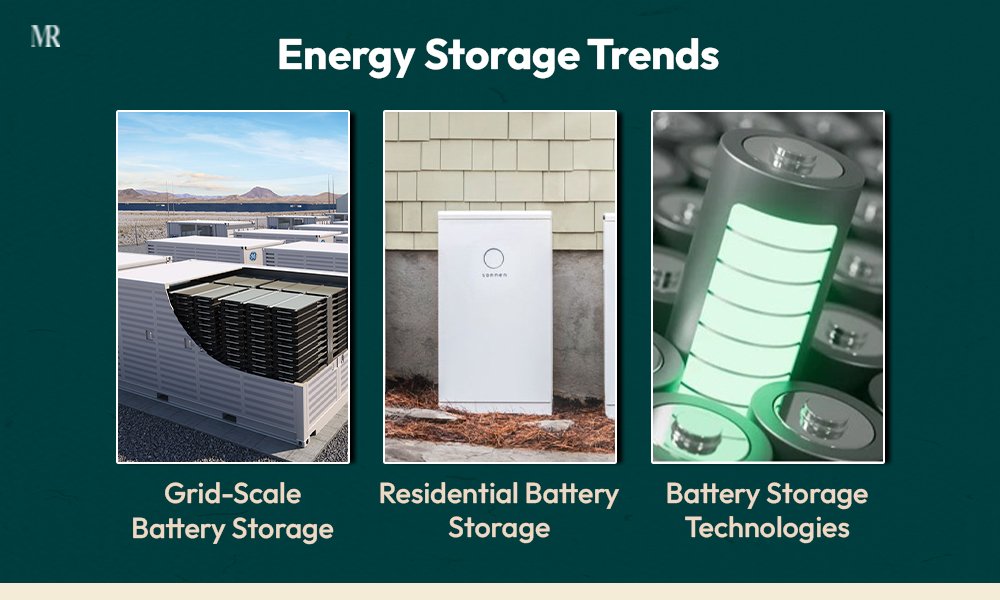
- Grid-Scale Battery Storage
Grid-scale Battery storage systems are crucial for integrating renewable energy sources into the electricity grid. They provide essential services such as frequency regulation, voltage support, and energy arbitrage. Advancements in battery technology and economies of scale are driving down the levelized cost of storage (LCOS) for grid-scale systems. This makes them more economically viable for utilities and energy providers.
Global energy storage installations are projected to reach 1,095 gigawatt-hours by 2030, with North America and Europe leading the market growth. China is also expected to dominate the Asian market due to its ambitious renewable energy targets.
Emerging technologies such as solid-state batteries, lithium-sulfur batteries, and flow batteries are enhancing energy density, safety, and longevity, making grid-scale storage more efficient and cost-effective.
- Residential Battery Storage
Residential battery storage systems, often paired with rooftop solar panels, enable homeowners to store excess energy for later use.
As battery costs continue to decline and economies of scale improve, residential storage systems will become more accessible to a wider range of homeowners.
Residential batteries will increasingly connect with smart home devices, allowing for optimized energy management and participation in demand response programs.
Residential storage systems will provide reliable backup power during grid outages, enhancing energy resilience for individual households.
The residential battery storage system is also getting popular across remote locations where grid supply is a big challenge.
- Battery Storage Technologies
Several innovative battery technologies are emerging as part of evolving energy and utility trends, offering alternatives to traditional lithium-ion systems. Sand batteries, using sand as a storage medium, provide scalable and cost-effective solutions for thermal energy storage, making them a promising option within these trends.
Aluminum-air batteries present an exciting opportunity for high energy density and lighter weight. On the other side, sodium-ion batteries are being explored as less resource-intensive alternatives to lithium-ion technology.
Additionally, graphene batteries are gaining attention due to their high conductivity and potential for extended longevity, reinforcing their importance in energy and utility trends. The diversity of these emerging battery technologies will significantly improve the efficiency and sustainability of future energy storage systems.
Electric Vehicle Trends
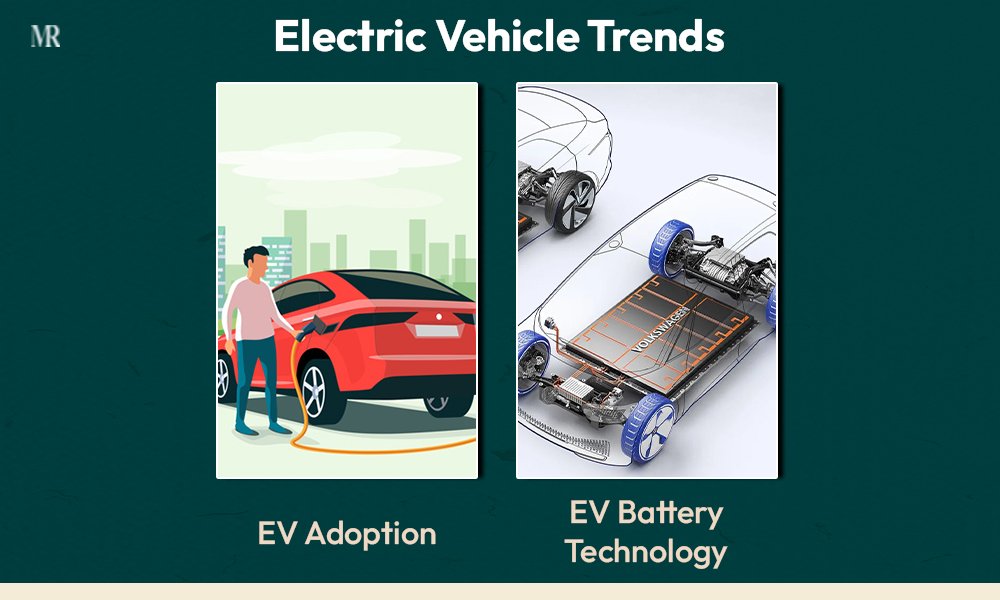
- EV Adoption
The role of electric vehicles (EVs) in achieving zero-emission targets by 2050 is critical. Moreover, the global market is evolving at a remarkable pace, driven by the need for cleaner, more efficient transportation solutions.
In recent years, the growth in the EV market has been exponential. Fueled by decarbonization efforts that many leading nations are prioritizing, this trend reflects the global urgency to address climate change.
As one of the prominent energy and utility trends, government policies and incentives have spurred EV sales, which reached nearly 14 million in 2023. This 35% increase from 2022 demonstrates the rapid rise in EV adoption. Furthermore, the global electric fleet now exceeds 40 million vehicles.
Looking ahead, the momentum continues in 2024, with sales in the first quarter already showing a 25% year-on-year. Experts predict that EV sales will surpass 17 million by the year-end, accounting for 20% of all global car sales. This surge highlights a significant shift in energy and utility trends, as e-mobility extends beyond core markets like China, Europe, and the USA, reaching more regions across the globe.
In 2023, the global EV market was valued at approximately $618.9 billion. As part of evolving energy and utility trends, it is projected to grow to $786 billion by 2024 and reach $3,877.2 billion by 2032. This expansion, at a compound annual growth rate of 22.1%, is driven by environmental sustainability concerns, advancements in battery technology, supportive policies, and growing public awareness. As such, the rise of EVs remains a key force in shaping the future of the energy and utility sectors.
- EV Battery Technology
Battery technology is at the heart of the electric vehicle revolution. Lithium-ion batteries remain the dominant technology; however, several emerging alternatives are gaining attention, like Solid-State Batteries, Sodium-Ion Batteries, Aluminum-Air Batteries, etc.
Improvements in battery chemistry are leading to enhanced range and reduced charging times for electric vehicles. Innovations such as silicon anodes and advanced cathode materials are helping increase energy density while decreasing costs. For example, some new lithium-ion batteries can fully charge in just five minutes, making them competitive with traditional fuel refueling times.
As the number of electric vehicles on the road increases, so does the need for effective battery recycling solutions. Companies like Tesla and Redwood Materials are developing methods to recycle lithium-ion batteries efficiently, reducing waste and minimizing environmental impact. Additionally, second-life applications for used EV batteries—such as energy storage systems—are being explored to extend their usefulness beyond automotive applications.
Signing off on Energy and Utility Trend
The energy and utility sectors are undergoing significant transformations driven by key trends in technology, sustainability, and consumer demand. Major trends include the rapid adoption of electric vehicles, advancements in battery storage technologies, and the shift towards renewable energy sources such as solar, wind, and geothermal. Additionally, the integration of smart grid technologies is enhancing the efficiency and reliability of energy distribution.
These trends have profound implications for the global economy and the environment. As companies pivot towards cleaner energy solutions, they not only contribute to reducing greenhouse gas emissions but also create new business opportunities and job markets. The transition to renewable energy sources is essential for achieving long-term sustainability goals and addressing climate change.
Staying informed about these energy and utility trends is crucial for individuals, businesses, and policymakers alike. Understanding the evolving landscape allows stakeholders to make informed decisions that align with future energy needs and environmental responsibilities.
Keep Reading! Keep Growing!

